Managing complex SEO processes can be overwhelming.
You know SEO SOPs are the answer. But where do you even start?
After four years in the agency business, I’ve learned a thing or two about designing SOPs that actually work.
Funny enough, we initially ended up with 300+ SOPs after two years of documenting everything. You can imagine how much of a mess it was.
And so I started “the big declutter”.
From that moment, I have been reviewing, optimizing, and archiving our SOPs every six months.
That’s when we started to truly improve our SEO processes.
Wondering how we did it?
In this guide, I’ll share our key learnings about building SEO SOPs and list the key types of SOPs you need to create.
What is an SEO SOP?
SOP stands for Standard Operating Procedure.
It’s a set of written instructions that describe how to perform a routine task, step by step, so that anyone can follow the procedure the same way.
An SEO SOP is a document that outlines step-by-step instructions for specific SEO tasks.
It helps your team members achieve the same results faster and provides clients with a harmonized experience, no matter who’s doing the work.
SEO SOPs cover things like keyword research, brief creation, technical audits, and more.
Why do you need SEO SOPs?
At Flying Cat, I’ve learned that SEO requires both creativity and consistency.
Our strategists often develop brilliant keyword strategies. But without proper organization, they can get lost in the chaos of Google Drive Folders.
Imagine having a master keyword document—crucial for handoffs between team members—designed in a way only one person understands?
SEO SOPs solved this problem. They provide a clear roadmap that balances creative freedom with necessary structure.
With SEO SOPs, you can:
- Make sure every team member has clarity about the expected end result when performing SEO tasks
- Train new hires and freelancers faster
- Delegate tasks without long explanations
- Scale your efforts without sacrificing quality
- Retain what works and ditch what doesn’t
In short, SEO SOPs help you do more, faster, with better outcomes.
Key types of SEO SOPs
We create two main types of SEO SOPs at Flying Cat:
- Guides and playbooks: Relatively large documents that serve for high-level inspiration and guidance. Aimed at specialists with SEO experience.
- Task-specific SOPs: Step-by-step instructions for specific tasks (like data collection) that can be delegated and followed even by non-SEO specialists.
These guides and SOPs are closely interconnected and help us support various aspects of each process.
The key processes we target with our SOPs include:
- Keyword research
- Creating content briefs
- Customer desire maps
- Sourcing SMEs
- Setting up content production
- Client content management
- SEO reporting
- Link building
- On-page SEO
- Keyword tracking
- Internal linking
Let’s see how it works in practice and explore what you can cover with SEO SOPs.
Keyword research
This SOP describes your process for finding and prioritizing target keywords. It helps you create high-performing content plans and lays the foundation for your SEO efforts.
Sample steps:
- Use tools like Semrush to generate initial keyword ideas. Do it by entering seed keywords and analyze your organic competitors.
- Analyze the key metrics (e.g., volume and keyword difficulty).
- Group keywords into topic clusters.
- Check the search intent for each keyword and decide whether it matches our needs.
- Shortlist and prioritize the keywords.
In our case, we included the high-level keyword research process in our SEO playbook for creative guidance.We then built a separate SOP focusing on operational aspects, such as:
- Frequency of the task
- Required resources
- Connected processes
- Team members involved
- Definition of task completion
Here’s what it looks like in our SOP:
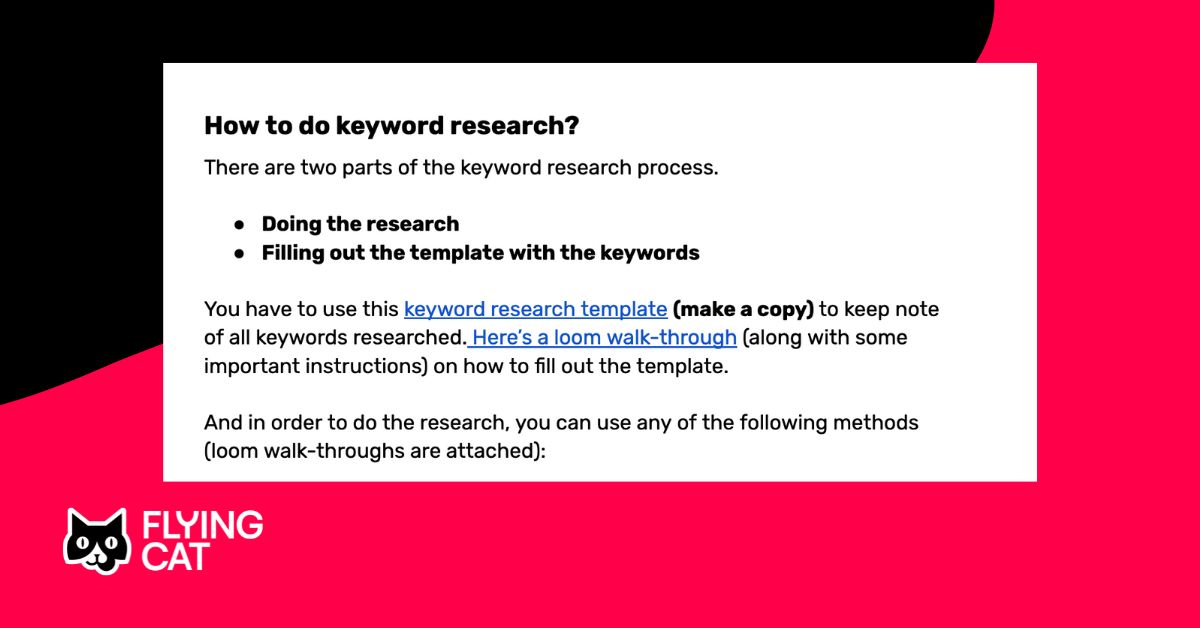
Creating content briefs
This SOP focuses on designing content briefs. It ensures consistency in your content and helps writers deliver high-quality pieces that are optimized to rank.
Sample steps:
- Add the target keyword and related keyphrases.
- Analyze top-ranking pages to understand search intent and content structure.
- Specify content type and target audience.
- Outline the main sections (H2s, H3s, etc.) and key points to cover.
- Include guidelines for tone, style, images, and internal/external linking.
- Add any specific CTAs or conversion goals for the piece.
- List relevant resources or examples for the writer to reference.
Similarly to keyword research, we included those steps in our SEO playbook. The operational aspects of designing content briefs are covered in separate SOPs.
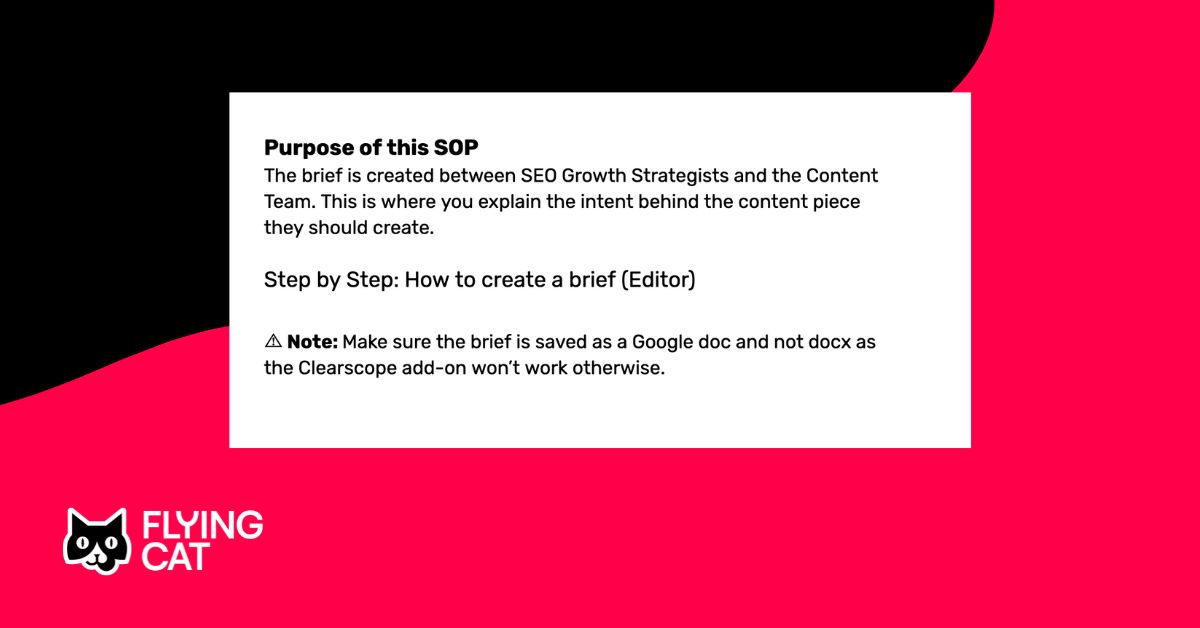
We also have a content brief template every team member can use. Here’s what it looks like:

This approach helps create a clear, step-by-step process for creating briefs and working with writers.
Customer desire map
A Customer Desire Map (CDM) captures the voice of your client’s customers. It’s a collection of insights, quotes, and data that helps you understand the needs of the target audience.
This SOP outlines how to create and use a CDM. It ensures your content resonates with users by addressing their real needs and concerns.
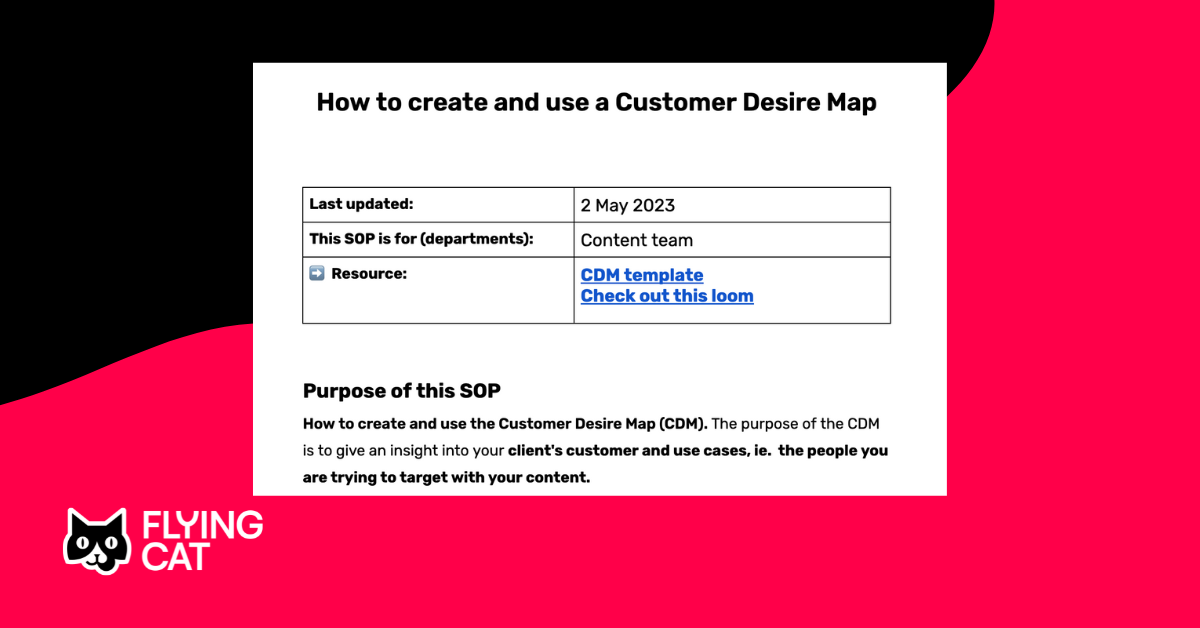
Sample steps:
- Gather customer insights from various sources.
- Organize feedback into meaningful categories (e.g., hopes and dreams, pains, etc.).
- Use the CDM to inform content creation and strategy.
- Keep the CDM updated regularly.
Sourcing SMEs
This SOP outlines the process for finding and engaging Subject Matter Experts (SMEs) to contribute to your content. It helps you favor E-E-A-T and create expertise-driven pieces.
Sample steps:
- Understand client expectations for using SMEs in content.
- Identify suitable platforms for finding SMEs (e.g., LinkedIn).
- Develop a strategy for reaching out to potential SMEs.
- Assess the quality and relevance of SME contributions.
- Properly integrate SME insights into your content.
We also include templates for conducting SME outreach:
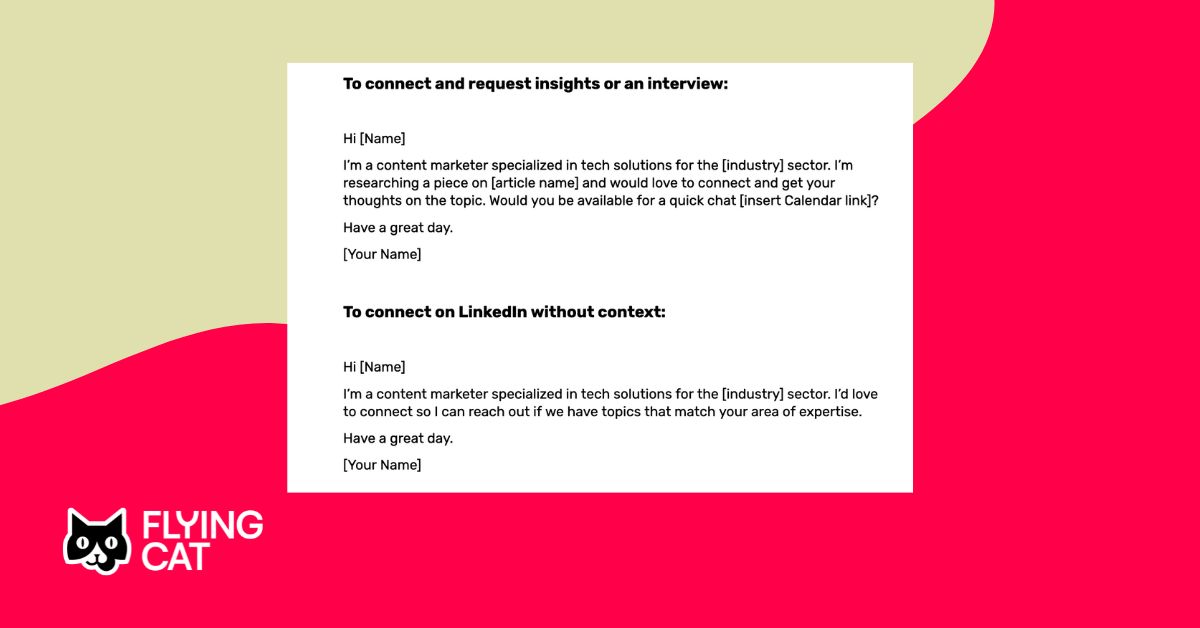
Setting up content production
This SOP focuses on building content creation workflow. It covers all key steps from brief creation to publication, helping you produce more quality content with fewer resources.
Sample steps:
- Define clear stages in your content production process (e.g., brief creation, writing, editing, client approval).
- Assign roles and responsibilities for each stage.
- Set up a project management tool to track progress (e.g., ClickUp or Notion).
- Establish checkpoints and approval processes.
- Implement automation where possible to reduce manual work.
- Create a system for managing client feedback and revisions.
You might also want to create a separate content publishing SOP.
Client content management
The client management SOP helps you organize all the content/SEO work for a specific client in one place.
In other words, you can use it to build customized digital workspaces for your clients.
Sample steps:
- Create a central spot with all the key info about the client—their website, brand guidelines, tone of voice, etc.
- Let everyone know who’s doing what for this client—SEO specialists, writers, editors, strategists.
- Adjust your standard process to fit how this client prefers to work.
- Organize the content pipeline to track all content pieces from idea to publication.
SEO reporting
Next, create a SOP for delivering regular SEO reports to your clients.
It’ll help you create a consistent and efficient reporting process that clearly shows the progress toward project goals.
Sample steps:
- Gather data from agreed-upon sources (Google Analytics, Search Console, etc.).
- Input data into the customized report template for each client.
- Analyze the data to identify key trends, wins, and areas for improvement.
- Write concise, clear explanations of the data insights.
- Have a team member review the report for accuracy and clarity.
- Send the report to the client at least 24 hours before the monthly meeting.
SEO reporting is extremely important for agency work. Here’s the specific process we follow at Flying Cat:
🚀Develop a base SOP for data collection.
🚀Customize it for each client based on their specific goals and metrics.
🚀Create a one-time video explaining each client’s reporting process.
🚀Review and update quarterly or when client goals change.
Here’s what it looks like:
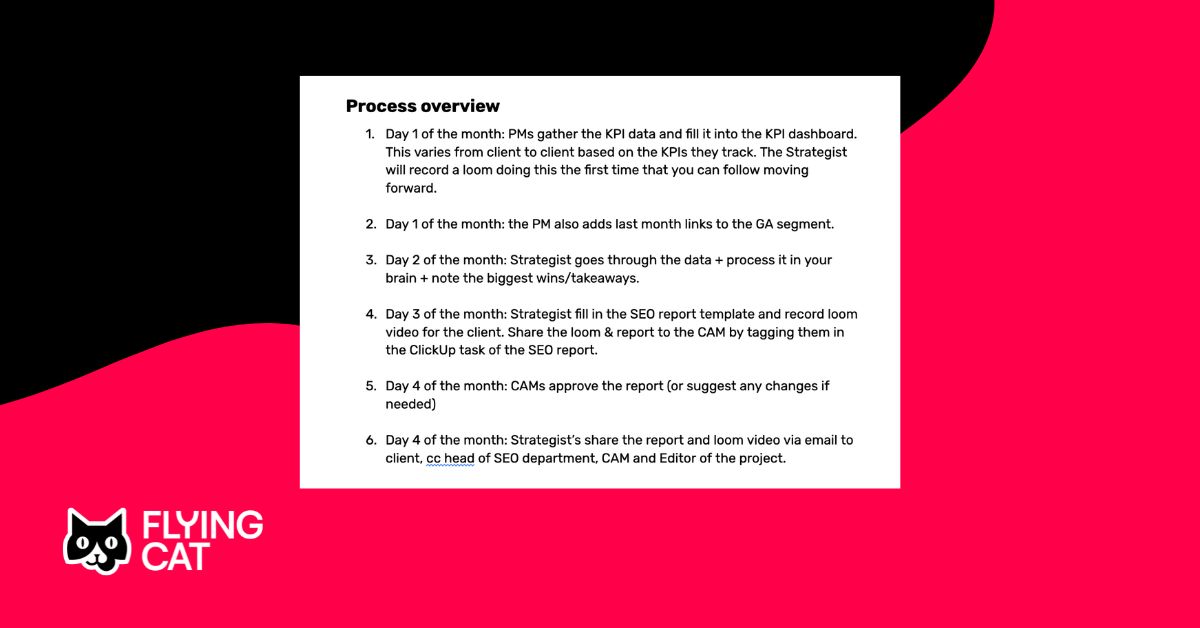
Link building
The link building SOP helps document your link building strategy and organize the outreach process.
Sample steps:
- Identify link building opportunities (guest posting, broken link building, link magnets, etc.).
- Research and create a list of potential websites to target.
- Analyze the authority and relevance of potential link sources.
- Develop outreach templates for different link building tactics.
- Conduct personalized outreach to website owners or content managers.
- Track responses and manage ongoing communications.
- Report on link building progress and impact on domain authority.
On-page SEO
The on-page SEO SOP outlines steps for optimizing individual web pages to rank higher.
It covers various processes, from keyword integration to search intent analysis.
Sample steps:
- Identify primary and secondary target keywords for the page.
- Analyze search intent for the core keyword.
- Optimize the title tag and meta description.
- Structure content with proper heading tags (H1, H2, H3, etc.).
- Incorporate target keywords naturally throughout the content.
- Add images and alt tags.
- Improve internal linking structure.
- Ensure proper URL structure and use of canonical tags.
- Optimize page load speed and mobile responsiveness.
- Implement schema markup where appropriate.
Here’s how we implement this at Flying Cat:
🚀Create a general SOP for on-page optimization.
🚀Provide a checklist of common on-page elements to optimize.
🚀Create videos for each step showing how to implement changes.
🚀Recognize that each page may have unique requirements and add room for flexibility.
Internal linking
An effective internal linking strategy helps you pass authority from one page to another and enhances user navigation.
This SOP describes the process for finding and incorporating relevant internal links into each content piece.
Same steps:
- Conduct a site-wide content audit to identify linking opportunities.
- Create a content hierarchy or topic clusters to guide linking.
- Build a repository of internal links.
- Use relevant anchor text for internal links.
- Identify and update outdated or broken internal links.
- Balance link distribution to avoid over-linking to certain pages.
- Use internal links to guide users through the conversion funnel.
- Regularly review and update internal links as new content is published.
Keyword tracking
The keyword tracking SOP focused on monitoring keyword rankings.
It helps you design a process for analyzing your SERP positions and implementing necessary actions.
Sample steps:
- Select appropriate keyword tracking tools (e.g., Semrush).
- Identify and group target keywords for tracking.
- Set up tracking for different search engines and locations.
- Establish a regular schedule for checking rankings (e.g., weekly, monthly).
- Analyze ranking changes and their potential causes.
- Identify opportunities for improvement based on ranking data.
- Report on keyword performance to clients or stakeholders.
Now, let’s see how to design those SOPs the right way.
Why do SEO SOPs often not work?
Have you ever bought a planner just to fill out one page and never touch it again?
That has definitely happened to me. Every January I used to buy myself the most beautiful bullet journal and even a fresh set of matching pens and stickers.
Months later, I had only filled out one page.
The same issue often happens with SEO SOPs. Because one thing is to create it, and another is to make sure it’s being used.
Here are the key mistakes you should avoid:
- Making SOPs too complex and hard to follow
- Not adding enough flexibility and room for quick changes
- Having your SOPs created by people without direct hands-on experience
- Not getting enough buy-in from your team and failing to communicate the value of SOPs
- Not establishing clear ownership and responsibilities
- Making your SOPs too generic
Remember, standardized operations should make things easier—not harder.
Integrating new processes is always a bit painful. Make sure your team understands the benefits of SOPs and knows who’s responsible for what.
Then, design SOPs that create value for your specific objectives and context.
How to create effective SEO SOPs
So, how can you create SOPs that avoid those mistakes and improve your SEO processes?
Let’s find out.
1. Start with the end in mind and identify your target SEO process
First, you’ll need to identify the SEO processes you want to standardize.
Look at the tasks your team performs regularly and pinpoint those that could benefit from a more structured approach.
You could prioritize tasks that:
- Need urgent delegation. For example, when a new team member is joining or when a senior-level person is spending time on tasks that could be done by someone more junior.
- Are messy or inconsistent. Focus on processes that change each time and require a lot of time to organize—such as conducting SEO client audits.
- Involve multiple team members. Find processes that require having a clear workflow to define who owns what—like content creation.
- Create the most value or delays. Look for tasks that significantly impact your team’s efficiency and client results—like keyword research and content planning.
Next, define the desired outcome of each SOP.
Imagine you’re creating a keyword research SOP.
In this case, your goal is to consistently find high-potential keywords that align with your client’s business goals and are possible to rank for.
Finally, use this information to set the stage for your SOP.
Create an executive summary and a table of contents at the beginning of each SOP. This will help users quickly understand the purpose of the SOP and navigate the document easily.
2. Identify the best practices and current bottlenecks
Now it’s time to analyze the current practices for each process you want to standartize. You’ll need to examine what’s working well and what’s holding you back.
Start by gathering your team for a thorough review of your current processes.
Encourage open and honest communication. Your team members who work directly with these processes daily often have the most valuable insights.
- Look for techniques that consistently yield positive results. These might be strategies that have led to massive improvements in rankings, methods that save time without sacrificing quality, or approaches that clients frequently praise.
- Identify bottlenecks that slow you down and lead to errors. Those could include time-consuming manual data collection for reports, delays in content creation due to unclear briefs, etc. Try to understand the root causes of those issues. For example, is it because you lack proper tools or due to unclear guidelines?
To stay on top of ongoing issues and improvement opportunities, implement an improvement opportunities log:
- Have the whole team contribute to this log, noting process errors or mistakes as they occur.
- Review the log as a team weekly, assigning owners to address each issue.
- Use this log to continuously refine and improve your processes, helping you smooth out workflows much faster.
As you go through this analysis, document everything.
Create a list of best practices you want to include in your SOPs and another list of bottlenecks your SOPs should address.
Remember, the goal here isn’t to criticize or blame someone (or something) for bottlenecks. Instead, present this as an opportunity to make everyone’s life easier.
3. Break this process down into detailed steps
Next, break down your SEO process into detailed, actionable steps. This is where your SOP starts to take shape.
Begin by listing out every step in the process, no matter how small it might seem. Be thorough—what might be obvious to you could be essential for a new team member.
Include the specific software needed for each step and any relevant settings or parameters.
For example, if you’re creating an SOP for keyword research, your steps might include:
- Open Semrush and navigate to the Keyword Magic Tool
- Enter the seed keyword provided by the client
- Filter results by search volume (minimum 1,000 monthly searches)
- Add a filter to exclude hard-to-rank keywords
- Export the top 100 results to a CSV file
- Open the CSV file in Excel and manually check the selected keywords
To make this process easier and more efficient, we use tools like Tango, which automatically capture our workflow and create step-by-step guides.
As you document each step, think about potential questions or confusion points. Ideally, interview a few team members and contractors to spot those.
In other words, treat your SOP like a product!
Finally, add visual guidance to your SOP. For example, we use Loom to record videos that walk users through the entire process and explain the steps included in the document.
Here’s a pro tip we’ve found useful: We often record a Loom video of ourselves performing the process while explaining each step, then use ChatGPT to create an initial SOP draft from our video transcript.
This saves us time and ensures we don’t miss any crucial details.
4. Design a quality control mechanism
Your next goal is to ensure that your SOP will be consistently followed and used correctly.
A quality control mechanism will help you get there.
First, identify key checkpoints in your process that require quality assessment.
A keyword research SOP could include the time after keyword prioritization and before final delivery to the clients.
Next, establish clear criteria for what constitutes quality at each checkpoint. These criteria should be specific, measurable, and aligned with your overall SEO goals.
For example, “All keywords should be directly related to the client’s business or industry” or “The average keyword difficulty score should fall within the predetermined range for the client.”
Finally, describe a review process where a senior team member or project lead checks the work against these criteria. For our keyword research SOP, it could involve:
- Reviewing the final keyword list for alignment with the client’s goals
- Evaluating whether the search volume and keyword difficulty correspond to the project objectives
5. Create templates and checklists
Now that you’ve broken down your processes and identified best practices, it’s time to create templates and checklists to summarize everything.
Here’s how you can do it:
🚀Use the detailed steps you’ve outlined to structure your templates and checklists.
🚀Incorporate the best practices you’ve identified during your research.
🚀Address the bottlenecks you’ve discovered by including reminders.
🚀Clearly mark your quality control checkpoints.
Always use clear language and logical ordering when building these templates, and compliment them with video instructions.
Would you like to save time on this step? Use the pre-created SEO SOPs we developed at Flying Cat!
6. Review and update your SEO SOPs regularly
Remember, your SEO SOPs require ongoing attention to remain effective. Schedule periodic audits to ensure they reflect the current processes and client needs.
To streamline this step, set a regular schedule for reviewing each SOP (e.g., quarterly) and assign responsibility for these reviews.
During such audits, consider:
- Changes in SEO best practices or algorithm updates
- Shifts in client needs or industry trends
- Feedback from team members using the SOP
- Data on the SOP’s effectiveness (e.g., time saved, error reduction)
Then, update your SOPs based on your findings. Incorporate new techniques or tools that have proven effective and remove outdated practices that no longer serve your goals.
Here’s how I do it at Flying Cat:
First, I check when an SOP was last viewed. If nobody has checked it out in the past 6 months, it means it’s not valuable anymore.
But before I chuck it, I need to investigate a bit more: is this because the SOP is not effective, or because our process has changed? It’s a fine line between:
- an SOP being too detailed, too specific, too long and too overwhelming.
- an SOP that is too general and only the person who created it can follow it.
To assess this, I collect direct feedback from my colleagues and make the necessary changes.
This process is essential to keep your SOPs effective and up-to-date.
Start building effective SEO SOPs
Creating effective SEO SOPs will help you scale your SEO processes and remove the bottlenecks that hold you back.
Remember, your goal is not to do everything as fast as possible.
Instead, focus on maximizing quality and establishing best practices.
Let’s recap the key ideas:
- You can create high-level playbooks and operational SEO SOPs for specific tasks.
- The most important processes to document include keyword research, brief creation, report delivery, technical audits, and others.
- Focus on processes essential for your specific context and prioritize them accordingly.
- Always start with your end goals in mind and involve various team members.
- Continuously audit and improve your SEO SOPs.
Using these tips, you can create effective SOPs that aid your team members and improve client satisfaction.
Ready to give it a try? Skip the hassle of creating SOPs from scratch.
Our pre-created SEO SOP toolkits are designed by experts who understand the challenges and needs of agencies like yours.
